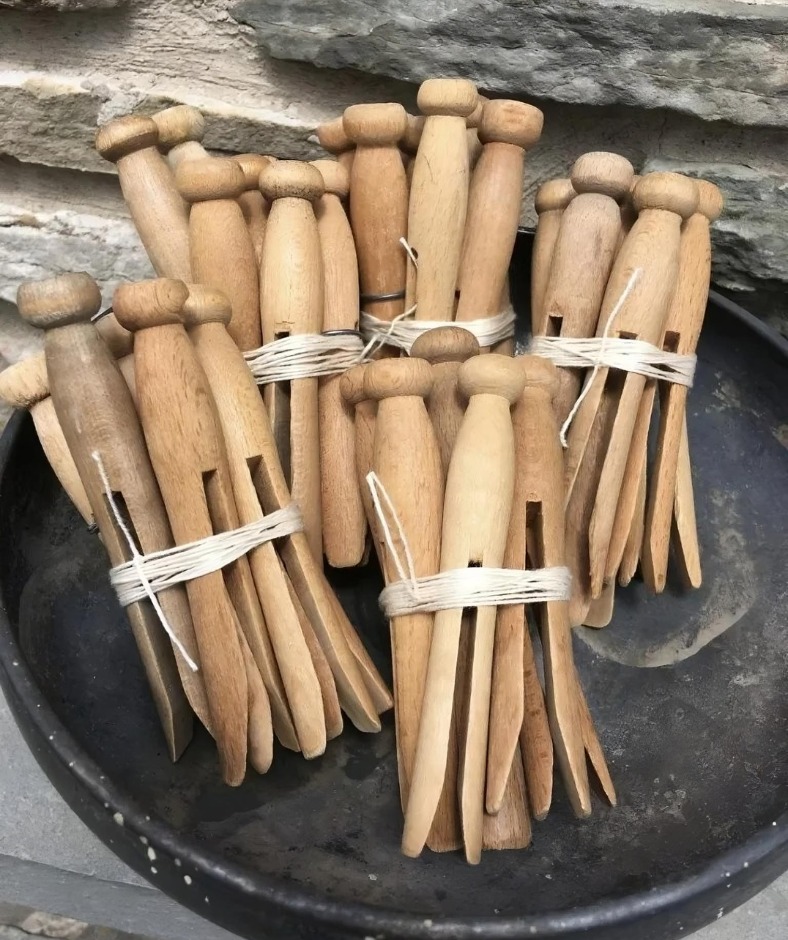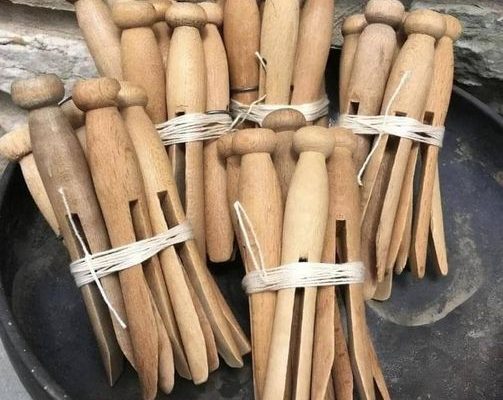“I have no idea what these are, but I found them at my grandma’s house.”
“I found these at my grandma’s house, but I have no idea what they are.” If you’ve ever stumbled upon wooden clothespins in an old drawer, you may have wondered about their history and use. While these simple household tools might seem outdated, they have been a staple since the 19th century. Beyond their humble appearance, wooden clothespins carry a rich history that connects us to a time when life was slower and simpler. Today, they remain both useful and nostalgic, proving their lasting charm. Let’s explore the origins of wooden clothespins and why they continue to be cherished in the modern world.

The Origins of Wooden Clothespins: 19th-Century Ingenuity
The story of wooden clothespins begins in the 19th century when laundry was a labor-intensive task. Before the convenience of electric dryers, people hung their clothes outside to dry, making clothespins essential for keeping garments on the line. Early clothespins were made from materials such as bone, horn, or metal, but wood soon became the material of choice due to its abundance and affordability.
These early wooden clothespins were often handcrafted by skilled artisans who took pride in their craftsmanship. The high-quality, hand-carved design ensured durability and functionality, reflecting a time when items were made to last. The fact that many of these clothespins have survived for generations speaks to their sturdy design and the emphasis placed on longevity in earlier eras.
Wooden Clothespins: Versatile Beyond Laundry
While wooden clothespins were primarily used for hanging laundry, they’ve proven to be far more versatile over time. Even with the rise of modern household technology, these little tools continue to serve multiple purposes in creative ways. Here are a few innovative uses for wooden clothespins in today’s world:
- Kitchen Helpers: Clothespins make excellent bag clips for chips or other snacks, keeping food fresh and reducing waste.
- Crafting Tools: In the crafting world, wooden clothespins are a favorite, used to make everything from holiday decorations to jewelry.
- Photo Holders: They can be used to hang photos, giving home decor a rustic, vintage charm.
- Organizational Aids: Clothespins help organize cables, cords, and small items around the house or office, keeping things neat and tidy.
In addition to their practicality, wooden clothespins are an eco-friendly alternative to plastic clips. Since they are durable, reusable, and biodegradable, they offer both an environmentally conscious and wallet-friendly solution for household needs.
A Symbol of Nostalgia
For many, wooden clothespins evoke a deep sense of nostalgia. They bring back memories of hanging clothes under the sun, with the rhythmic sound of fabric flapping in the breeze. Using clothespins reminds us of simpler times, perhaps recalling childhood summers spent helping with laundry or watching our grandparents work outdoors.
In today’s fast-paced, tech-driven world, wooden clothespins represent a return to slower, more meaningful moments. They connect us to the resourcefulness and ingenuity of earlier generations, offering comfort and a link to the past. In an age of instant gratification, the act of using these timeless tools can remind us to slow down and appreciate the smaller things in life.
Staying Relevant in the 21st Century
Despite advancements in laundry technology, wooden clothespins have remained relevant for more than a century. Their simple, effective design has endured because it works. Wooden clothespins are not only functional but also have a tactile appeal that stands out in today’s digital world.
You can still easily find wooden clothespins available for purchase both in stores and online, indicating their continued popularity. People value them not only for their practical uses but also for their aesthetic appeal. Whether repurposed for crafts or used in traditional laundry routines, wooden clothespins continue to inspire creativity and retain their charm.
A Connection to the Past
Wooden clothespins serve as a tangible link to a shared past, reminding us of an era when life moved at a slower pace and practicality was prioritized over convenience. The design of clothespins has evolved over the years, but their essence remains the same, making them a beloved household item across generations.
In many ways, using a wooden clothespin today is an act of honoring that history. It connects us to the craftsmanship and practicality of the past, reminding us that sometimes the simplest items are the most valuable. Wooden clothespins represent sustainability and simplicity, showing us that true utility never goes out of style.
Conclusion: The Lasting Legacy of Wooden Clothespins
Wooden clothespins stand as a testament to the power of simplicity and practicality. Their timeless appeal and multifunctional uses have kept them in homes for more than a century, and their continued popularity suggests they will remain a staple for years to come. In a world that’s always rushing forward, wooden clothespins remind us to slow down, appreciate the moment, and find joy in the everyday tasks that keep life running smoothly.
So, the next time you come across a wooden clothespin, take a moment to reflect on its rich history. Even the smallest, most unassuming objects can carry a lasting legacy, connecting us to the past and helping us appreciate the simple beauty in everyday life.



